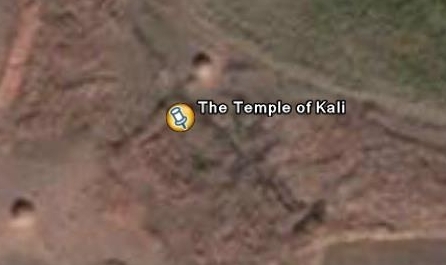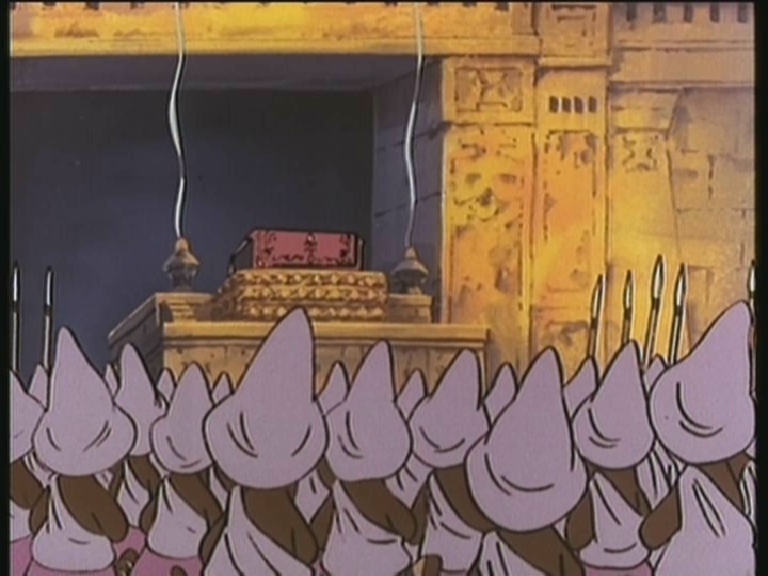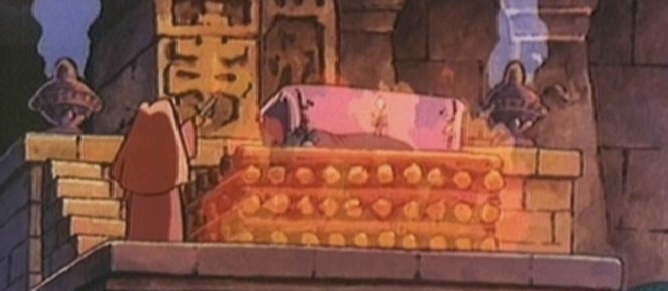BlankI apolgise in advance if this entry seems a little longer to both read
and to compose, but I am in the middle of a situation at the moment. You
will remember that yesterday we had a small problem in the form of a lack of
transport (which was solved by Passepartout finding an elephant), well
today's problem is how to rescue a potential suttee.
The day started nice and early at 8.00am with about half the distance to
Allahabad to go, however by 4.00pm today that had all changed as this
interesting little procession headed our way. It was the Parsee who
suggested that we keep out of the way and given the procession's motive that
seemed a very sensible move as it appeared to be a funeral procession with
the poor person's widow being unable to deal with the notion of her
husband's death and having to be propped up by a couple of guards. Or at
least that's what I thought was the case until the Brigadier informed me
that what had actually passed us was a procession to celebrate the act of
suttee. Now at this point, my box of tricks pinged into life and offered an
explanation of the concept, but I could see that the Brigadier was on the
cusp of explaining it as well so decided to see how well the two sources
converged and they converged very nicely indeed.
"The Indian custom of a widow burning herself, either on the funeral pyre of
her dead husband or soon after his death. Sometimes, the wife was immolated
before the husband's expected death in battle, and it was then called
jauhar. The custom possibly has links with ancient beliefs that a man needed
his companions in the afterlife as well as in this world. During the
medieval period the hardships encountered by widows in traditional Hindu
society may have contributed to its spread. Numerous suttee stones,
memorials to the widows who died in this way, are found all over India, the
earliest dated AD 510. The first reference to the practice in a Sanskrit
text is in the Mahabharata, in which some queens undergo suttee; but it is
mentioned by the 1st-century-BC Greek author Diodorus Siculus in his account
of the Punjab in the 4th century BC. In the Muslim period the Rajputs
practiced jauhar to save women from dishonour by foes, most notably at
Chitorgarh. The larger incidence of suttee among the Brahmins of Bengal,
particularly during 1680–1830, was due indirectly to the Dayabhaga system of
law which prevailed in Bengal and which gave inheritance to widows. At its
best, suttee was committed voluntarily, but cases of compulsion, escape, and
rescue are known. Steps to prohibit it were taken by the Mughal rulers
Humayun and his son Akbar, and it was abolished in British India in 1829.
Instances of it continued to occur in Indian states"
And that was precisely what we had stumbled upon, but then it got worse as
the Parsee informed us that the widow in question had in fact been kidnapped
from a neighbouring state by the followers of the goddess Kali as the Rajah
(whose body the procession was following) was a firm believer in the deity.
"Kali is a major Hindu goddess whose iconography, cult, and mythology
commonly associate her with death, sexuality,violence, and, paradoxically in
some of her later historical appearances, motherly love. Although depicted
in many forms throughout South Asia, Kali is most often characterized as a
black or blue goddess, partially or completely naked, with a long lolling
tongue, a skirt or girdle of human arms, a necklace of decapitated heads,
and multiple arms. She is often depicted standing or dancing on her husband,
the god Shiva, who lies prostrate beneath her. Kali was originally most
likely a deity of the tribal and mountain cultures of South Asia who was
gradually appropriated and transformed, if never quite tamed, by the more
traditional and public pan-Indian Sanskritic traditions. She makes her first
major appearance in Sanskrit culture in the Devi-Mahatmya (“The Greatness of
the Goddess") where she springs from the angry brow of the goddess Durga to
slay the demon Raktabija. Her paradoxical nature, deeds of violence and
grace, and ecstatic secrets have since then been displayed, encoded, and
meditated on in a wide range of Sanskrit, vernacular, and artistic media
(Puranas, Tantras, philosophical treatises, meditation manuals,
sculpture,ritual theatre, vernacular songs) up to the present. Kali's cult
has been particularly popular at different points of Indian history in
Kashmir, Kerala, South India, Bengal, and Assam. She has thus inhabited a
space “on the edges” of the subcontinent and culture in both a geographic
and a doctrinal sense"
In other words, a very nasty piece of work indeed. So I said something that
seemed to take everyone by surprise and suggested that we rescue the poor
lady, and that's what we are doing right now. The only problem is how to do
it. Passepartout has been a real marvel with this camera like device and the
Brigadier has been pouring over the evidence.
As you can see it's a fairly imposing building where the act of suttee will
take place in about 6 hours time and we had a good scout round to see what
we could do to get in. Unfortunately it's very well guarded and so that
ruled out a direct approach and yet all the time we were planning, the
followers of Kali were getting ready as you can see in this picture.
Hold on a second, this looks a bit serious I must say. There's some activity
going on. Let me see if I can take a picture.
Oh, no. We've waited too long and they've lit the pyre. There's no other
option. A direct attack it will have to be, but hold on something's
happening.
The pyre's just collapsed for some reason and someone's standing up? What?
Coming Brigadier!
Well, Well, Well. Clearly I shall have to add not only manservant, gymnast
and fireman to Passepartout's list of achievements but also spectral actor.
Why you may ask? Well, it was Passepartout that caused the pyre to collapse.
In the confusion he stood up and proclaimed himself to the ghost of the dead
Rajah and whilst doing so, picked up the Rajah's widow, and calmly walked
out from the pyre and straight into waiting arms. Clearly, the next thing to
do is to get this poor lady to Allahabad, and then Calcutta as quickly as
possible and then decide what do to there. I will say this though, I can see
why the Rajah married her, she looks a very nice young lady.
--
No virus found in this outgoing message.
Checked by AVG Free Edition.
Version: 7.1.408 / Virus Database: 268.13.9/490 - Release Date: 20/10/2006
Send instant messages to your online friends
http://uk.messenger.yahoo.com
Received on Tue 24 Oct 2006 - 07:37:20 IST






 JV.Gilead.org.il
JV.Gilead.org.il